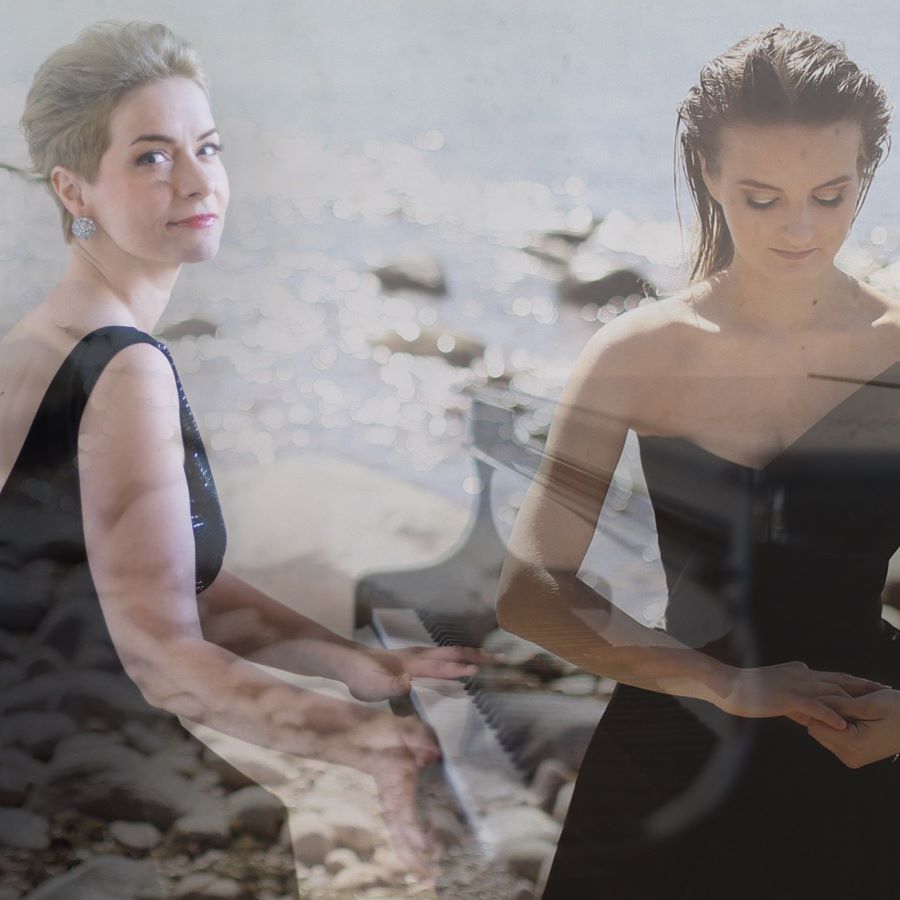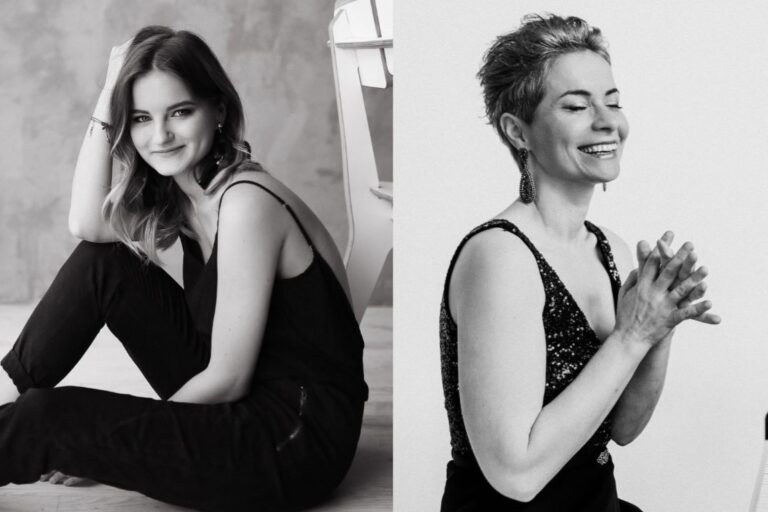

A concert program exploring and connecting Swiss and Lithuanian piano repertoire through the combination of traditional and contemporary music.
Regard sur les traditions
Concert programme
Mikalojus Konstantinas Čiurlionis. String Quartet in C minor, VL83, Allegro moderato (transc. for piano solo by Mūza Rubackytė),
Nik Bärtsch. Modul Solo from “8 Moduls for Piano Solo”,
Dieter Ammann. “Regard sur les traditions” for piano 4 hands,
Loreta Narvilaitė. “Alpių traukinys” (“Train of Alps”) for piano 4 hands,
Kristupas Bubnelis. “Chromatography” for piano solo,
Nik Bärtsch. Modul Solo from “8 Moduls for Piano Solo”
Discover the programme
Exploring Swiss and Lithuanian piano repertoire led two pianists of the same origin, Eglė Andrejevaitė (based in Lithuania) and Akvilė Šileikaitė (based in Switzerland) to the exploration and combination of traditional and contemporary music landscapes, captivating cross-cultural journey, tracing the threads of musical influence that bind these two nations and composers, across sounds, time and space.
The concert programme includes both classical/traditional (Čiurlionis) and modern music pieces (Ammann, Bubnelis, Narvilaitė) for piano solo and piano 4 hands, influenced by traditional forms or musical language, explored through composer’s personal glimpses and transformed to individual experiences both for performers and the audience. From experimentation and improvisation to genre-defying fusion (Bärtsch), this program showcases the diversity and dynamism of musical expression. It also delves into the collaborative elegance of two pianists sharing a single instrument, crafting a harmonious symphony of synchronized melodies. This performance format transcends the solitary nature of traditional piano playing, inviting audiences into a dynamic dialogue with music and musicians.
Eglė Andrejevaitė...
Lithuanian concert pianist puts special emphasis on the performance of the new music. Her recent program BALTIC AMBER was commissioned by the “New Music Encounter Plus 2023” festival in Brno, The Czech Republic. The most celebrated recital programs – Beethoven Hour (2015), Engraving dedicated to the 100th anniversary of the Baltic States (2018), Chopin Haiku (2020) and its version with famous Lithuanian actress Birutė Mar Winter In Mallorca (2021) received success in Lithuania and were also presented for the audience in Australia and USA. Active both as soloist and chamber musician she made her debut in Graz Philharmonic, Austria in 2012 with her piano-violin Duo (Jusionytė – Andrejevaitė) and in 2013 Duo received a Special Jury Prize for the outstanding performance of contemporary composition at International Johannes Brahms Chamber Music Competition in Poertschach, Austria. MALLORCA PRELUDES – the first album of the pianist will be released in 2024. >>> www.andrejevaite.com <<<
Akvilė Šileikaitė...
Akvilė Šileikaitė is a pianist, photographer and painter born in Lithuania, yet now based in Switzerland. Because of her great interest in chamber music and accompaniment, orchestral music and new music, her repertoire consists of a wide scope of different styles and compositions, ranging from timeless baroque compositions to contemporary music. In 2015, Akvilė and Valentine Michaud (saxophone) founded the AKMI duo that has not only made an unforgettable debut at the prestigious Wigmore Hall in London and Salle Cortot in Paris, but also received the Swiss Ambassador’s Award (2019). The duo has also made its debut at world renowned “Lucerne Festival”, “Festival Radio France”, “Lavaux Classic”. Akvilė is also actively performing with swiss percussionist Fabian Ziegler, works with Emmanuel Pahud, Barbara Hannigan, composers such as Francesco Filidei, Matthias Pintscher, Arash Safaian, performs in festivals like “Davos Festival”, “Label Suisse”, “Tage Neue Musik Zürich” and on concert stages in Zürich Tonhalle, Lucerne KKL, Musikverein Wien, München Gasteig, etc. >>> www.akvilesileikaite.com <<<
More about composers and compositions
Mikalojus Konstantinas Čiurlionis (1875-1911)...
Mikalojus Konstantinas Čiurlionis (1875-1911) is the most seminal and emblematic figure in the history of Lithuania’s national culture. At the junction of the 19th and the 20th centuries he embodied the aspirations of a national revival movement and linked them with the latest tendencies in European art of the time. In his life, Čiurlionis’ ambition to become a professional artist started interfering increasingly with his work as a composer. He first became known for his pioneering paintings, in which he synthesized his musical experiences and often gave musical titles (e.g. Prelude, Fugue and Sonata) to the most visionary among his works. Olivier Messiaen referred to him as to “a remarkable composer of music and paintings,” noting an unusual and deep linkage between his works of music and art.
String Quartet in C minor (transc. for piano solo by Mūza Rubackytė) his best-known piece of string music is “Quartet in C minor”, although the composer himself was not completely satisfied with it (because he had to meet the traditional and academic requirements of the Leipzig Conservatory professor Carl Reineckes when creating it): “I feel that I can create a quartet a hundred times better.” According to musicologist Vytautas Landsbergis, the music of “String Quartet in C minor” is graceful, romantic, full of homesickness and memories of Lithuania. As pianist and professor Mūza Rubackytė noted “it also became evident that a piano transcription of the piece would be necessary in order to present the creative legacy of Lithuanian painter and composer to an international audience”.
Nik Bärtsch (1971*)...
Nik Bärtsch (1971*) is a Swiss pianist, composer, bandleader, record producer and author from Zürich. Repetition and change are central motifs in his music and performance practice. Nik Bärtsch’s work is at the intersection of contemporary music, jazz and funk influences. Bärtsch is influenced by oriental philosophy and the ostinato of James Brown, taken a close interest in the work of the American composers Steve Reich, John Cage and Morton Feldman. For all the diversity of its influences, this music always reveals its own signature – although elements from a wide variety of musical worlds have found their way into it – from funk and jazz to new classical music and the sounds of Japanese ritual music – these forms are not juxtaposed or quoted in a postmodern way, but rather merge to form a new style. The result is a grooving, tonally and rhythmically highly differentiated music, composed of a few phrases and motifs that are combined and overlaid in ever new and varied ways.
8 Moduls for Piano Solo
Composer’s note – This piano cycle consists of eight Moduls, set here for piano solo. They can be played separately or in variable combinations and order, depending on the context and capability of the player. While the interpretations on the recordings sometimes differ from the score, they still precisely follow the idea and coherence of the pieces.
Loreta Narvilaitė (1965*)...
Her rational principles of composing and construction of musical forms often based on some graphic lines or numerical sequences. Yet, the adherence to strict rules has in no way limited the scope of her imagination and artistic intuition. Works composed over the past decade demonstrate the increasing importance of an emotional element as well as the turn from minimalism to neoromantic expression. She describes her current work as the music of changing emotional states. Restless and constantly racing with time, she is in action all the time. So is the mood, in which you will find yourself while listening to her music: you are about to sense the bursting energy of sounds.
“Alpių traukinys” (Train of Alps) for piano 4 hands
The composer’s infinite admiration for Switzerland and its landscape led to the composition for piano four hands “Alpių traukinys”. Based on various ostinato patterns, as allusion to train ride, the change of harmonies and characters opens a different musical horizon that emerges like a new corner of the Alps, causing new emotions and creating postcard memories.
Dieter Ammann (1962*)...
Dieter Ammann was born in Switzerland, into a highly musical family. Following his studies at the Academy for Music Education and Church Music in Lucerne and several semesters at the Swiss Jazz School in Berne, he started to perform as musician in the field of improvised music and jazz. Subsequently he studied theory & composition with Roland Moser and D. Müller-Siemens at the Music Academy Basel, followed by master classes, amongst others with Wolfgang Rihm and Witold Lutoslawski. In the nineties, composing became his main focus.
Regard sur les traditions for piano 4 hands
although the term “tradition” in this composition refers to literature of Messiaen and Ligeti, it is also reflected in the sound of this piece. If from Messiaen he uses one of his modes, Ligeti stands for the mechanization of musical movement. One concern was to break the traditional style of writing “top: melody – bottom: accompaniment” in a variety of ways so that the two players become congenial partners. Of further compositional interest is the change in perception of a mechanically repeated pattern by continuously accelerating or slowing it down (linear versus vertical listening). The addition “avec quelques trompes d’oreille”, borrowed from painting that works with optical illusions, refers primarily to the second part of the piece, where the impression of rhythmic shifts arises within a uniform motor movement.
Kristupas Bubnelis (1995*)...
His music is born of tradition, extends it and even declares it. The work of the composer, who studied in Vilnius and London, began with a historicizing approach to sound. He did not sought to be modern in the true sense of the term, but to convey through himself what is already known and close. After taking a closer look at the tradition and, undoubtedly, making it the foundation for his further work, the composer gradually moves away from the influences of the past and approaches post-spectral expression.
Chromatography
Composer’s note – when I started writing this piano etude, my initial idea was to look at the sound of the instrument through a perspective of colour. Broadly speaking, the title Chromatography translates as colour writing, or colour drawing (χρώμα + γραφικά). On the assumption that colour is a frequency, we can equally regard musical parameters, such as harmony, timbre, register, pulse, etc. as frequency – a variation of a pulse. Throughout the piece, there are indirect references to the great tradition of piano repertoire, spanning over two hundred centuries: Liszt, Chopin, Debussy, Ligeti, Nancarrow… From the free-flowing lines to shimmering Ravel-Esque textures, this Etude invites on a journey across the whole colouristic landscape of the piano, despite its uniquely unified timbre.


